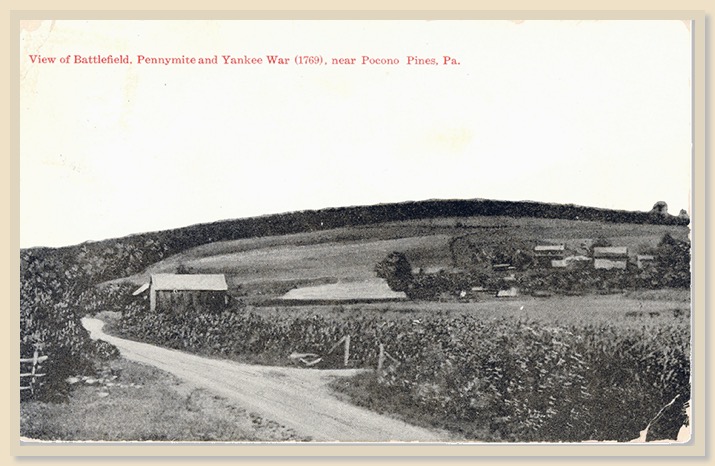
(The inscription on this postcard, circa 1910, has an incorrect date).
and its role in The Yankee-Pennamite Wars
By Fred Lehrer
Pennsylvania, however, also had a royal charter that gave it title to the territory in question. Native American tribes claiming ownership of the region further complicated the matter. The rights of contesting parties became a matter of considerable controversy.
Differences of opinion were largely academic until 1769, when Connecticut established its first permanent settlement in Pennsylvania. Pennsylvania settlers had no intention of sharing their land with the Connecticut invaders, and repeatedly employed force to push them out.
The series of conflicts between the Yankees (Connecticut settlers) and Pennamites (settlers loyal to Pennsylvania colony) created turmoil in the Wyoming Valley for years to come. Those conflicts became known as the Yankee-Pennamite Wars.
First Yankee-Pennamite War • 1769-1771
The First Yankee-Pennamite War began in 1769 and was fought until August 1771. After some skirmishing and the harassment of local officials, a Connecticut army major by the name of John Durkee marched on Pennsylvania, erecting the Forty Fort, named for the first 40 settlers who came to the Wyoming Valley. He later erected Fort Durkee and reinforced his position with an army of about 300.
When Durkee was captured and his fort seized by Pennamite militia, Zebulon Butler took control of the Connecticut forces in Pennsylvania. Butler’s Yankees won the war by 1771 by first recapturing Fort Durkee, and then capturing the Pennamite-built Fort Wyoming on the banks of the Susquehanna River with a 26-day siege.
After this First Yankee-Pennamite War, part of the Wyoming Valley became known as Westmoreland, and was under the control of Connecticut’s Litchfield County.
Second Yankee-Pennamite War • 1775
The Second Yankee-Pennamite War took place in 1775, beginning with skirmishes and ambushes between the settlers and militias of the Wyoming Valley. This short but bloody confrontation ended at the Battle of Rampart Rocks on Christmas Day 1775.
Here an unknown number of Yankees under Zebulon Butler defeated approximately 600 Pennamites under Colonel Plunkett. The Yankees used the natural cover of the Rampart Rocks cliffs near the Nanticoke Falls to inflict heavy casualties on the Penns, who retreated after considerable losses.
Shortly thereafter, the Yankees and Pennsylvanians put their differences aside to join forces against the British during the Revolutionary War. They entered into a treaty, and each supplied fighting men to the Continental army and the militias of the patriot cause.
It was Butler who led the Yankee militia during the Revolution, up until the infamous Massacre of Wyoming Valley, in the wake of the Battle of Wyoming on July 3, 1778.
Following America’s War for Independence, Connecticut lost all sympathy and support for their distant claims in Pennsylvania. In 1782 the Decree of Trenton confirmed that the Yankees were illegally settled in the Wyoming Valley, and had lost their rights as citizens of the Commonwealth of Pennsylvania.
Third Yankee-Pennamite War • 1784
But the Third Yankee-Pennamite War was fought in 1784 after a Yankee army burned the fort at Wilkes-Barre and then abandoned the settlers of the Wyoming Valley. While this third war was brief, bloodshed and a low-intensity guerilla conflict of sorts would continue for years after, not completely ending until 1794. Part of the renewed Yankee campaigns from 1784-1790 began when 700-800 Yankee settlers were forcefully driven from their lands. In addition to losing their claims, hardships in the wilderness after their eviction by the Pennamites cost some of the Yankees their lives.
The Battle of Locust Ridge
Due to continuing attacks and occupations by the Yankees, a Pennamite militia force was raised in July 1784 by order of Pennsylvania’s Supreme Executive Council.
Under the command of Col. John Armstrong, an advance guard under Maj. Moore was assembled at Learn’s Tavern in Tannersville on August 1 and moved north via Sullivan’s Road. Hearing of the approaching Pennamite militia, the Yankees dispatched Capt. John Swift from the Wyoming Valley with 30 men to meet and defeat the militia before they could reach the valley.
An engagement ensued at Locust Hill in today’s Tobyhanna Township on August 2, in which Jacob Everett, one of Moore’s men, was killed. Several others were wounded on both sides of the conflict.
Moore’s unit retreated to Easton, and Swift’s defenders returned to the Wyoming Valley.
On August 8 Col. Armstrong advanced on the Wyoming Valley with 315 militiamen. Armstrong demanded the Yankees lay down their arms. When the Yankees surrendered, Capt. Swift’s company of men, who had defeated Moore at Locust Hill, were bound with cords and handcuffed. In this condition they were marched away to jail in Easton. Forty-two others were bound and sent to jail at Sunbury. Col. Armstrong then returned to Philadelphia covered with infamy.
The Sunbury prisoners were released on bail. The Easton prisoners procured their liberty through Edward Inman, a man of great physical strength, who knocked down the jailer, seized the keys, and liberated himself and his comrades. Fifteen of them escaped to Wyoming, but 11 were taken and confined in jail for three months. An attempt was then made to indict them for the murder of Jacob Everett. The attempt, however, proved a failure for the grand jury ignored the charges.
Editor’s Note: The name of Locust Hill was changed through the years to Locust Ridge.